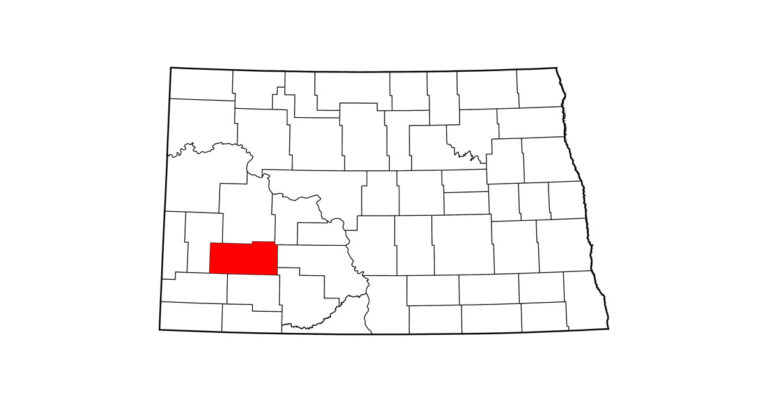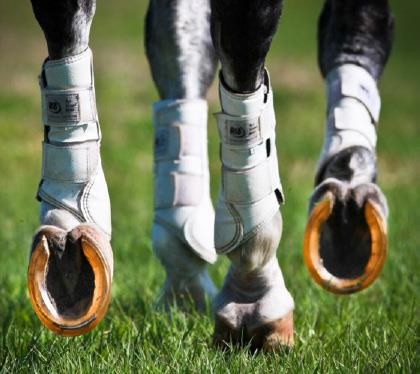
like the Polyflex shoe, tend to be more flexible than metal shoes and since they’re
designed to be glued on, they’re useful for horses with weak hoof walls that can’t hold a nailed-on shoe. No Anvil LLC
Weak, shelly hooves—too damaged to hold a shoe—threaten to keep a high-level jumper out of the ring. What can be done? The owner can take the horse out of work and wait for the damaged hoof walls to grow out, hoping that in a few months the hooves will be stronger. But today, says Adam Whitehead of Advanced Equine Podiatry in Ocala, Florida, “Technology has made it possible to solve problems like this and keep horses going.” Adam outfitted this jumper with glue-on shoes in front and shock-absorbing pour-in pads on all four feet, and the horse didn’t have to miss a competition.
In this article top farriers outline five developments that are changing the way horses—especially horses with hoof problems and chronic lameness—are shod. Besides Adam, formerly head farrier at the University of Florida and now in private practice, you’ll hear from Pat Reilly, chief of Farrier Services and director of the Applied Polymer Research Laboratory at the University of Pennsylvania’s New Bolton Center, and Dave Farley of Coshocton, Ohio, and Wellington, Florida, a past president of the American Association of Professional Farriers.
Odds are your horse, like most, goes in nailed-on metal shoes. “That’s how horses have been shod for 400 years,” Pat says. “It works well for a lot of horses and has many benefits, but it also has some drawbacks.” For example, nails can compromise the hoof capsule, and a hoof in a nailed-on metal shoe doesn’t wear or expand under weight in the same way it does barefoot. To address those drawbacks and help horses with soundness issues, farriers are turning to new materials and designs.
No Nails
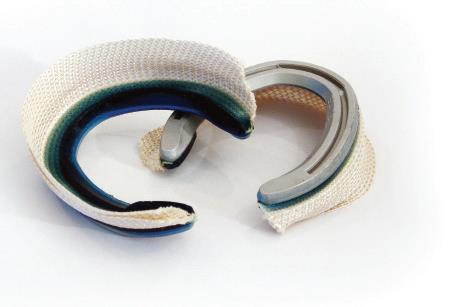
Technologies. The aluminum shoe is laminated to a shock-absorbing urethane rim pad and a polymer fabric cuff. Sound Horse Technologies
Pat ranks the introduction of glue-on shoes as the biggest change in horseshoeing since the Civil War era. His predecessor at the University of Pennsylvania, farrier Rob Sigafoos, did pioneering work on glue-ons in the 1980s, adapting adhesives used in airplane manufacturing. “Early versions made use of cyanoacrylate adhesives—basically Super Glue—that became brittle when exposed to moisture,” Pat says. “Horses live in wet conditions, so the shoes would fall off. Glue-ons got a bad rap.”
New adhesives that hold up under wet and other adverse conditions have made glue-on shoes practical, however. They’re becoming more common in the sporthorse world, especially for horses with thin-walled, brittle, cracked or shelly feet and other issues that make nailed-on shoes problematic. These shoes typically cost significantly more than nailed-on shoes, but they may have benefits beyond allowing
such horses to stay in work. “I don’t know
of any research showing this, but I’ve observed
that in many horses hoof growth
improves with these shoes,” Dave says.
“The shoes are often put on as a last resort
and then the foot improves.”
There are several types of glue-on
shoes, and farriers tend to have individual
preferences. Adam and Pat often use
a current version of the Sigafoos shoe,
made by Sound Horse Technologies. It’s
an aluminum shoe laminated to a shock absorbing
urethane rim pad and a polymer
fabric cuff. Although the concept
dates to the 1980s, “The shoe has been
manufactured commercially and widely
sold only in the last decade,” Adam says.
“It can’t be hot-forged, but I can shape it
for any purpose and build shoes not feasible
with a forge.”
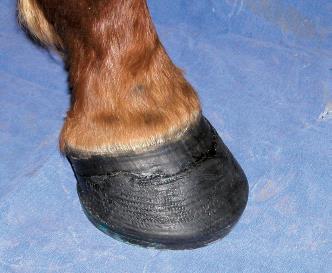
to the hoof, the outside fabric cuff is said to have more than twice the holding power of eight clinched nails and is unaffected by moisture or temperature. Sound Horse Technologies
To attach the shoe, the farrier saturates the fabric cuff with an acrylic adhesive and then applies the cuff to the outside of the hoof. “The fabric becomes part of the hoof-wall structure and helps it become stronger,” Pat says. According to the manufacturer, the attachment has more than twice the holding power of eight clinched nails and is unaffected by moisture or temperature.
̬New fast-setting urethane adhesives have made it possible to glue shoes directly to the ground surface of the hoof, too. “You can take an aluminum shoe, “butter” it with adhesive and apply it to the foot,” Pat says. The urethane adhesives set in one minute and cure in six. Aluminum shoes are used because the adhesive bonds better with metal than with steel. The hoof surface must be thoroughly cleaned and dried to get a good bond, though.
Direct-glued metal shoes are generally used as a temporary measure—for example, to keep a horse in work while damaged hoof wall grows out. Because the shoes are affixed to the base of the hoof wall all the way to the heels, they limit the ability of the hoof to expand at the quarters and heels when the horse loads his foot. “The hoof still moves in a direct-glued aluminum shoe, but not as much as in a nailed-on shoe,” Pat says. This may not cause problems over a few shoeing cycles, but if the horse stays in direct-glued metal shoes long-term it can lead to contracted heels and other issues.
Acrylic and urethane adhesives are also being used to repair toe and quarter cracks and similar injuries to the hoof wall. “I see less use of screws and wires for this,” says Dave, who has been shoeing horses for almost 50 years. The new materials bond better than those used in the past, he adds, and when mixed with various fibers can be used to rebuild badly damaged hooves. These reconstructions are strong enough that often a regular shoe can be nailed on.
Synthetic Shoes
While metal shoes are still the norm, synthetic shoes made of polyurethane are being used by some top performers. “These shoes bend a little more than metal,” Pat says. “There are various designs. None are perfect, but they’ve come a long way and are now viable alternatives.”
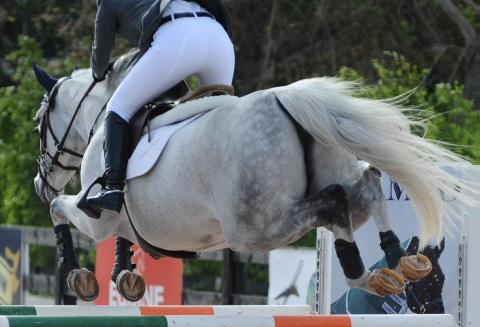
are becoming popular for hunters, jumpers and dressage horses. They allow the quarters and heels to expand under the horse’s weight more than metal shoes and may also help deflect the shock of landing from a jump. No Anvil LLC
One popular design, the Polyflex shoe, is made of polyurethane with a wire insert that allows the shoe to be shaped to the foot like an aluminum shoe. Farrier Curtis Burns of Wellington, Florida, first developed these shoes as an alternative to aluminum racing plates to reduce concussion and allow more natural expansion of the heels in racehorses. His company (No Anvil LLC) now makes several designs for sporthorses.
“Polyurethane shoes are coming on big for hunters, jumpers and dressage horses, although they’re used less in eventing,” Dave says. “They provide a little more flexibility than metal shoes and since they’re designed to be glued on they’re especially useful for horses with weak hoof walls that won’t hold a nailed-on shoe.” As direct glue-ons, polyurethane shoes allow the quarters and heels to expand under weight more than metal shoes do. They may also help deflect the shock of landing.
An early complaint with synthetic shoes was that they didn’t wear well. Better-wearing versions have been developed, but they still don’t last as long as steel shoes. “Most horses go about four weeks between shoeings with synthetics. This isn’t an issue for upper-level horses, who are typically done that often anyway,” Dave says. Faster wear can actually benefit some horses with chronic foot problems, he adds, because through wear the shoe adapts to the foot and the horse’s way of going. “The farrier can see the wear pattern and can do a more accurate job of trimming the next time the horse is shod. Hoof conformation improves and the horse is more comfortable and moves more freely.”
High-Tech Pads
New materials and designs have changed hoof pads from simple protective barriers to super shock absorbers. Made from a wide variety of polymer gels, foams, honeycombs and rubbery elastomers, these high-tech pads are especially useful for horses with chronic soreness.
Adam often creates pads using pour-in urethane s on as a a rubbery solid that holds its shape. It was developed by Ric Redden, DVM, to help horses recovering from laminitis. Silicone-impression-molded materials were introduced by Rob Sigafoos some years ago at the Applied Polymer Research lab. “Most of the work here now is focused on improving materials,” Pat says. Among recent advances is the use of hydraulic crumb silicone as an additive in pads made of materials such as silicone or urethane. The firmness of hydraulic crumb silicone increases with the amount of force placed on it, so it becomes firmer and more resistant to pressure when the horse gallops or jumps but softens when he’s just hanging out.
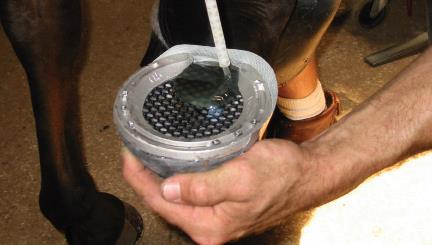
pad that is therapeutic for horses with chronic soreness. Vettec
Some older pad designs are finding wider uses. The flapper pad, sometimes called the flip-flop, has been used in the Standardbred industry for 40 years but is now showing up in the hunter and dressage worlds. This hard plastic pad is applied with a tip shoe (half shoe) fitted into a recess at the front. The back half of the pad, which isn’t nailed or glued to the hoof, supports the frog, quarters and bars. “It’s useful for horses with chronic heel pain or underrun heels,” Dave says. “The tip shoe and flip-flop pad allow the horse’s heels to function more naturally, as they would if the horse were barefoot, while still protecting the foot. This helps stimulate growth at the heels and over time improves hoof balance.” He notes that because the pads are partly open over the sole, they should be flushed out regularly with a jet of water from a hose so that compacted dirt won’t build up underneath.
Traditional leather pads breathe and conform to the foot while providing protection. They still work well for most horses, Dave says, and today’s leather pads are better and more consistent in quality than those of the past.
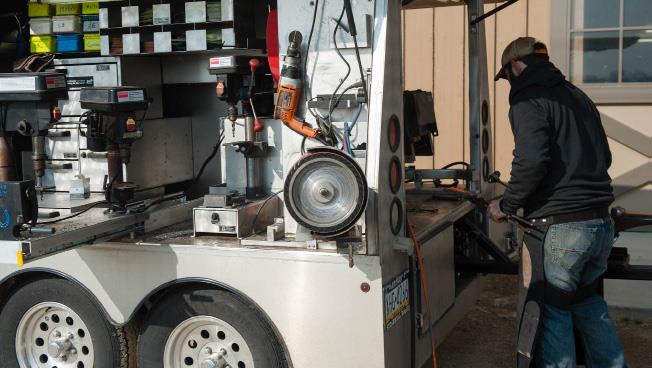
Better Basics
Farrier, forge, hammer, anvil—the basics of horseshoeing have been constant for hundreds of years, Pat observes. “Machine-made shoes, which appeared during the U.S. Civil War, brought the first major change to the practice. Before that, every shoe was hand-forged individually,” he says. Machine-made shoes and nails are still the most widely used items on any farrier’s truck, but even these basics are changing.
The sheer variety of high-quality ready-made horseshoes is one of the biggest changes. “We can buy steel shoes in every style and size, including shoes shaped and sized differently for front and hind feet,” Adam says. The shoes still need to be shaped to the individual horse’s feet, but the farrier is able to get a better fit with less labor.

Farrier Product Distribution
Advances extend right down to the nails. “Manufacturers are producing better-quality nails and nails that are sized for use with specific shoes,” Dave says. Copper-coated nails, first used in Europe and available this year in the United States, are the latest development. Dave has been using them in a trial for about a year. Copper-coated nails, he explains, may help prevent infections in cases of a nail prick (when the nail impedes on the sensitive living tissues of the hoof). Much else has changed for the farrier, Dave adds. Traditional tools have been redesigned to be ergonometric, so they fit the farrier’s hands better and make the job simpler and easier. And manufacturers are producing purpose-built trailers and truck bodies fitted out with roll-out power tools and everything else a farrier might need.
More Knowledge
Adam says farriers have long been guided mainly by tradition—so much so that the profession has been called “2,000 years of tradition unimpeded by progress.” But that’s changing. “A huge amount of good information about functional anatomy and other subjects related to shoeing is available today to anyone who wants it. Farriers who do a lot of specialty work, as I do, need that knowledge.” Adam says. “We have all these amazing things available to us now as farriers and as horse owners, but technology by itself is not enough. The knowledge of functional anatomy and how the technology is applied are what’s important.”
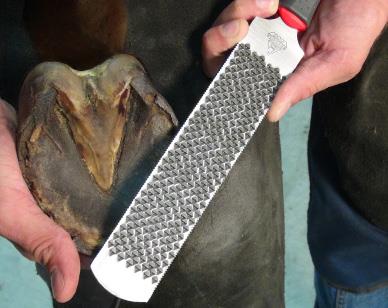
redesigned to more comfortably fit in a farrier’s hand. Farrier Product Distribution
Dave ranks information technology as the No. 1 change in the profession. “Word of new things from manufacturers and distributors, which previously might have taken a year or more to filter through the profession, spreads fast on the Internet and through social media. And continuing education, both online and through clinics, has really taken off,” he says. The AAPF has also started a mentoring program, bringing back a way of learning that was part of the profession 100 years ago.
“It’s been said that it takes 10 years or 10,000 horses for a farrier to figure out what’s right and what’s wrong. That has probably been cut in half in the last ten years,” Dave says. And increasingly, farriers are becoming a prime source of information for horse owners and caretakers. “The industry has acquired a lot of smart people who are interested in keeping up with new developments and educating owners. They’re helping to steer their clients toward practices that benefit horses.”

and 3-D printed a set of lightweight titanium shoes for a racehorse.
Though it was a huge leap in shoeing technology, it’s unlikely that custom 3-D printed shoes will become a normal occurrence for average horses because of the cost and specialized printer needed. CSIRO
What’s Next?
Australia’s Commonwealth Scientific and Industrial Research Organization broke new ground in 2013 by using a 3-D printer to produce a custom set of super-light titanium shoes for a racehorse. The same group later printed custom shoes for a horse recovering from laminitis. Meanwhile, other researchers are investigating new materials for shoes, including fiber-reinforced ceramics and Nitinol, a nickel-titanium alloy with memory—it’s elastic and gives under stress but then returns to its original shape.
So, will the shoer’s truck pull up to your barn with a 3-D printer or a rack of ceramic shoes on board? Not soon, the farriers say. Besides practical hurdles and questions of cost, these and other technological developments have to answer a basic question: What are the advantages?
“I take a practical approach with any new design,” Pat says. “Does the shoe help the horse? It’s often not clear, as we have no research.” To get answers, Pat worked with Tekscan Inc., a South Boston firm, to develop a pressure-sensitive electro-conductive membrane that can be sandwiched between the hoof and the shoe. It shows how force is distributed over the weight-bearing surfaces of the foot.
Even with that device, getting evidence to scientifically defend new developments is challenging. Pat says, “There are so many variations in farrier practices, footings and hoof growth that we can’t really say, ‘This shoe will help every horse.’ We can only say, ‘This shoe helped this horse.’“
As new materials continue to be developed, refined and combined in new ways, he adds, horse owners should keep in mind that individual farriers should use the materials they are comfortable with: “Not every farrier has the experience to work successfully with the new materials. If they don’t, they should consider referring clients to specialists who do have that experience.”






